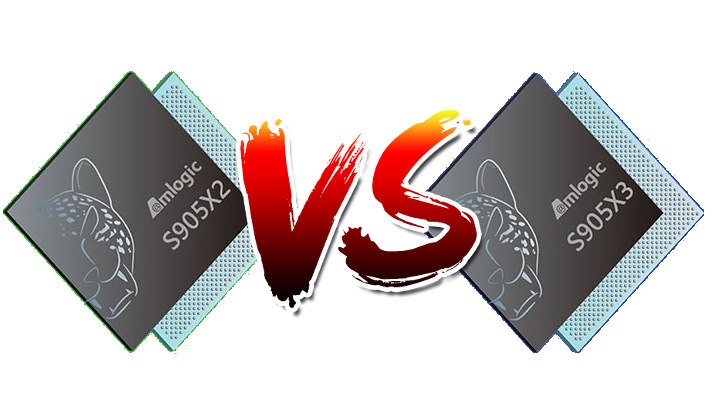Despite Arm claiming Cortex-A55 core would bring some performance improvements, we’ve recently seen actual Amlogic S905X3 benchmarks show the performance compared to Amlogic S905X2 Arm Cortex-A53 is almost identical (3% improvement for S905X3 CPU, 9% for the GPU).
So Amlogic S905X3 TV box processor must differentiate itself from its predecessor by its additional features, and while we published the detailed specifications of Amlogic S905X3 processor a few months ago, we did not provide a side-by-side comparison table just yet. So here’s one courtesy of SDMC (with some corrections).
| SoC | Amlogic S905X2 | Amlogic S905X3 |
| CPU | 4x Arm Cortex-A53 @ 1.80 GHz | 4x Arm Cortex-A55 @ 1.91 GHz |
| Neural Network Accelerator | N/A |
Optional 1.2 TOPS NNA |
| GPU | Mali-G31 MP2 with OpenGL ES 3.2, Vulkan 1.0, and OpenCL 2.0 | |
| Always-on MCU | Cortex-M3 & Cortex-M4 | (Optional ) Cortex-M3 & Cortex-M4 |
| DDR | DDR3-2133 /DDR3L-2133 / DDR4-2666 /LPDDR3-2133 /LPDDR4-3200 SDRAM up to 4G |
DDR3-2133 /DDR3L-2133 / DDR4-3200 /LPDDR3-2133 / LPDDR4-3200 SDRAM up to 4G |
| Video Decoding |
H.265, VP9, AVS2 up to 4Kp75 10bit H.264 4Kp30 | |
| HDMI Tx | HDMI 2.1 HDCP2.2 | |
| HDR | HLG/HDR10/ 10+ Dolby visonTCH PRIME | |
| Process | 12nm | |
| Mic Input | 8 x PDM | |
| USB3.0/PCIE | USB3.0/PCI-E V2 (multiplexed) | |
| Package | 14 x 14mm BGA | |
| Embedded Temperature Sensor | Yes | |
The Neural Processing Unit (NPU) / Neural Network Accelerator (NNA) is probably the most important change, as it should allow for better support for voice commands, language processing, or other workloads that would benefit from AI acceleration.
The higher maximum frequency for DDR4 memory (3,200 MHz vs 2,666 MHz) may explain the slightly better 3D graphics performance since I’ve noticed such benchmarks are sensitive to memory bandwidth, e.g. systems with dual-channel memory will have better graphics performance than the ones with single-channel memory. It may also help with some 4K HDR content (TBC).
But all-in-all Amlogic S905X2 and S905X3 are not that different.

Jean-Luc started CNX Software in 2010 as a part-time endeavor, before quitting his job as a software engineering manager, and starting to write daily news, and reviews full time later in 2011.
Support CNX Software! Donate via cryptocurrencies, become a Patron on Patreon, or purchase goods on Amazon or Aliexpress






CA55 — hallelujah!
Excited about 32-bit processors? 😉
https://www.cnx-software.com/2019/07/06/beelink-gt1-mini-2-amlogic-s905x3-tv-box/#comment-564508
Excited about Amlogic doing the switched to CA55 finally. I don’t plan on acquiring any S905 equipment any time soon.
The one to watch out for is S905X4 with AV1 support. Fundamentally everything after S905X is nearly the same with slightly higher CPU performance and more bugs.
I just realized the post i made at the Beelink GT1 Mini-2 is better pushed here:
The rise of S905X2/G31 MP2 setups has had some interesting developments in the market:
– Embrace to OpenGLES3. The Allwinner H6, prior to the S905X2 a more ”mid-field” SOC (With the S905 variants being overly common) has now taken its place, and its one of the cheapest OpenGLES 3 capable devices out there.
– Embrace for 4 GB ram. On the aforementioned H6, a 4 GB DDR3 machine with 32 GB NAND is between 35 and 45 bucks. These were normally features reserved for high end boxes, and most S905 boxes still feature 2 GB.
There are games out there demanding more than 2 GB ram, AND OpenGLES 3. Allwinner H6 and now S905X2/X3 (And S912) offer this for relatively cheap, so in terms of modern gaming support, these machines are definitely interesting.
The outliers are the Rockchip RK3318/28/3329 based boxes. Having 4 GB ram, but just a mere Mali 450 MP2, even away from MP3. These come in comparable prices as a AllWinner H6 (slightly lower) but in terms of gaming, they are firmly rooted in lesser demanding titles. COD Mobile wouldn’t run on it, for instance.
However, i think those boxes are great entry level machines that do highlight a lot multimedia support.
So in terms of graphics feature set support, Id argue that the arrival of S905X2 has caused other vendors to drop their older hardware down, like the H6.
I understand it is beyond the scope of this site, but i for one would love to see a multi SoC comparison article seeing how these things perform in gaming. I know a lot of people use these for the multimedia prowess, but combined with a gamepad, they are basically game consoles.
If nothing else, with Sentio, they can be even used as PC’s, which, admittely, might be an interesting topic to pursue for CNX.
That’s a good point, actually. The advent of truly entry-level GLES 3.1/3.2 devices might do more for the proliferation of the standard than things like Jetson Nano et al, generally considered GPU-centric SBC.
More benchmarks for S905X3, really S905D3 can be found @ https://www.cnx-software.com/2019/10/16/khadas-vim3l-amlogic-s905d3-benchmarks-settings-system-info/
Does anyone know what the safe operating temp of the S905x3 is? I have a X96 max plus box and the temp can get up as high as 77 degree C.
What I’m seeing in the very similar S905D3 datasheet for the Khadas VIM3L is that it supports 105°C junction temp and 70°C ambient. Assuming you’re reading the temperature from the internal sensor, you’re subject to the 105°C limit so you’re pretty fine.
Does your X96 Max Plus have DDR3 or DDR4 ?
Anyone flash an s905x3 firmware on a s905x2 box or is that not a good idea..lol